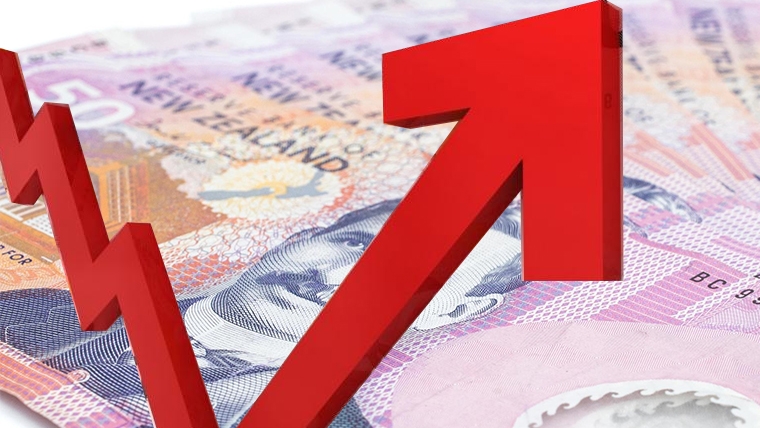
Newsflow has been light again. US equities have recovered after their one-day dip and US Treasury yields show small movements. Overnight, the NZD is the best performing currency we closely follow, recovering a lot of its loss seen after the RBNZ’s dovish 50bps cut yesterday, trading around 0.5780.
The S&P500 is currently up 0.6%, with the market probing fresh record highs again after yesterday’s modest fall. The tech sector is leading the gains, with investors disregarding warnings of a developing AI bubble. Both the IMF and BoE warned about the AI boom could turn into a bust, with both drawing parallels with the dot-com bubble in 2000. This brings memories of ex-Fed Chair Greenspan warning in late-1996 about the irrational exuberance in the US equity market. He ended up being right, although his warning came more than three years too early.
The Euro Stoxx 600 index rose 0.8% to a fresh record. Japan’s Nikkei index fell 0.5% off a record high a day earlier. The NZX50 rose 0.3% to a record closing high, not quite matching the record intraday high set in 2021.
US Treasuries show small movements, with slightly rates and a slightly flatter curve. We are publishing just ahead of the FOMC minutes for the September meeting, which are expected to highlight the divergent views on the committee. The 10-year rate is currently 4.12%.
Sentiment around France improved after outgoing PM Lecornu reported good consultations with other parties that could allow a new budget by the end of the year. The promoter of the recent increase in the retirement age said she was open to suspending that law if it meant bringing stability to the country. This helped the France-Germany 10-year spread narrow a couple of basis points.
The economic calendar has remained light. German industrial production slumped 4.3% m/m in August, a much greater fall than expected, although forewarned by yesterday’s poor factory orders data. An 18.5% drop in auto production, partly explained by annual plant closures for holidays and production changeovers, was a key driver. The data suggest that the weak German economy persisted in Q3 and raised the risk of a technical recession.
Spot gold blasted up through USD4000 per troy ounce with ease yesterday and has since traded at a fresh record high of USD4059.
The USD DXY index is approaching a two-month high, with the index back up through 99. Bloomberg reported traders saying hedge funds buying more bearish euro and yen option bets was a factor. This is reflected in risk reversals for the DXY index, which sit at their highest since April for the one-year tenor, suggesting more bullish than bearish bets are being placed on the dollar in the options market.
Positive risk sentiment has supported commodity currencies overnight. The NZD is the best performing currency we closely follow, recovering a lot of its loss seen after the RBNZ’s dovish 50bps cut yesterday. The NZD fell from 0.58 just ahead of the policy update, down to a low of 0.5737 and it has since recovered to around 0.5780. It has recovered fully on most of the key crosses following underperformance of EUR, GBP and JPY overnight.
An exception is against AUD, with NZD/AUD currently 0.8780, but higher overnight after probing a fresh multi-year low just below 0.8740.
EUR/USD took a peek just below 1.16 this morning and it currently sits just above the figure, while NZD/EUR has recovered to 0.4980. NZD/GBP found support at the April low just above 0.4280 and has since recovered to 0.4320. The yen remains under pressure, with traders looking to test the boundaries of when the MoF might intervene to stem the rout. USD/JPY touched as high as 153 overnight and NZD/JPY has recovered to 88.3.
The RBNZ’s policy update was very much at the dovish end of expectations in delivering a 50bps cut to the OCR to 2.5% and with forward guidance saying, “the Committee remains open to further reductions in the OCR as required”. The reason for the larger rate cut at this meeting reflected risk management rather than a reaction to new data. Of note, the RBNZ downweighted the 0.9% contraction in Q2 GDP, saying that the Committee has revised its assessment of current spare capacity only marginally in response to new GDP and activity data. The case for a 50bps cut rested on the chance of prolonged spare capacity in the economy and its associated downside risks to medium-term inflation.
With the market evenly balanced between a 25bps or 50bps cut, there was always going to be a significant market reaction to either decision, and the more dovish update drove down NZ rates and the NZD.
By the close, the OIS market was pricing in exactly 25bps of cuts for the next meeting in November, but the terminal OCR fell 8bps to 2.12%, reflecting a cumulative 38bps of cuts priced through into next year. Economists are united in expecting a 25bps cut in November and saying that will probably be the end of the easing cycle, albeit with risk slightly skewed to even lower rates, as priced by the market.
The swaps curve steepened but only a little, with the 2-year rate down 6bps to 2.57% and the 10-year rate down 4bps to 3.70%. The NZGB curve was steeper, with 6-7bps falls at the short end, a 5bps for the 10-year rate and 2bps falls for the ultra-long bonds.
It's a quiet day on the economic calendar, with just the FOMC minutes of the September meeting out by the time most readers receive this report.
Daily exchange rates
Select chart tabs
Jason Wong is the Senior Markets Strategist at BNZ Markets.

We welcome your comments below. If you are not already registered, please register to comment.
Remember we welcome robust, respectful and insightful debate. We don't welcome abusive or defamatory comments and will de-register those repeatedly making such comments. Our current comment policy is here.